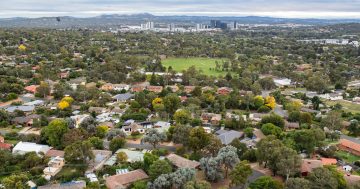
Some residents say recent storm damage is proof that gum trees don’t belong in the suburbs, but one arborist says that’s too simplistic a view to take. Photo: Jess Tankard.
Following the recent storms which tore through large swathes of the Belconnen and Gungahlin region, many residents have voiced their concerns about the suitability of gum trees for the suburbs.
Giant eucalypts, or gum trees, have earned the nickname ‘widowmakers’ as they tend to drop or shed large branches – often onto cars or houses.
Some residents took to Facebook to share stories of frustration after the storms, saying they had been trying for years to have the gum trees removed by the ACT Government without success.
Others said they were “terrified” of the gum trees out the front of their property and did not think “they have a place in the suburbs”.
“Gumtrees should not be near houses as they drop branches and debris on our cars in the driveway and street constantly,” another resident wrote.
But level five arborist at Treeworks Steve Griffiths said this analysis was too simplistic.
Mr Griffiths did acknowledge, however, that he and his team have seen gum tree “failure”, which has resulted in property damage.
One reason they are perceived as a threat is they are so common, making up around 60 per cent of the ACT’s tree canopy. But Mr Griffiths explained that failures in gum trees are often due to problems with the soil the trees are growing in rather than an inherent problem with the species.
“The main problem is a lack of drainage,” he explained. “It’s not that the trees are not suitable for the suburbs, but the soil is being compacted by the urban infrastructure.
“In a forest, for example, the water would simply flow away because the soil is very fluffy and porous underneath.”
The more infrastructure there is, the harder it becomes for water to drain away. Periods of heavy rain exacerbate this and can lead to a rotting of the roots. In a big wind, a tree with rotted roots can simply fall over.
As to what can be done, Mr Griffiths said a focus should be on soil health, including mulching around the base of the tree.
But sometimes, there are structural issues above the ground which mean some trees or branches will be unsafe in storms.
That’s why Mr Griffith said it’s important to call in an arborist to look at any trees or branches you might be concerned about. Any branches which appear to be dying should be removed by a professional.
If a member of the public is concerned about a tree on public land, they can raise the issue with the ACT Government.
According to the City Services website, the ACT Government takes a “conservative approach” to tree removal.
“When a member of the public expresses concern regarding public safety or the health of a tree on public land, a site visit is arranged and the subject tree or trees are assessed by qualified staff,” the site reads.
Region Media has sought comment from the ACT Government.
For more information about tree management, visit City Services.





















